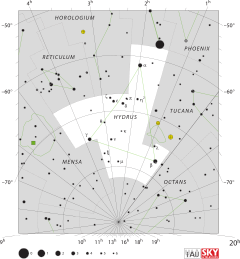Alpha Hydri
| Observation data Epoch J2000.0 Equinox J2000.0 | |
|---|---|
| Constellation | Hydrus |
| Right ascension | 01h 58m 46.19467s[1] |
| Declination | −61° 34′ 11.4948″[1] |
| Apparent magnitude (V) | +2.90[2] |
| Characteristics | |
| Spectral type | F0 IV[3] |
| U−B color index | +0.189[4] |
| B−V color index | +0.290[4] |
| Astrometry | |
| Radial velocity (Rv) | +7[5] km/s |
| Proper motion (μ) | RA: +263.66[1] mas/yr Dec.: +26.77[1] mas/yr |
| Parallax (π) | 45.43 ± 0.44 mas[1] |
| Distance | 71.8 ± 0.7 ly (22.0 ± 0.2 pc) |
| Absolute magnitude (MV) | +1.153[6] |
| Details[3] | |
| Mass | 2.0[7] M☉ |
| Radius | 3.040±0.058 R☉ |
| Luminosity | 21.00±0.75 L☉ |
| Surface gravity (log g) | 3.67±0.20 cgs |
| Temperature | 7,087±47 K |
| Metallicity [Fe/H] | 0.07±0.10 dex |
| Rotational velocity (v sin i) | 118 km/s |
| Age | 810[6] Myr |
| Other designations | |
| Database references | |
| SIMBAD | data |
Alpha Hydri, Latinized from α Hydri, is the second brightest star in the southern circumpolar constellation of Hydrus. It is readily visible to the naked eye in locations south of 28°N with an apparent visual magnitude of +2.9. It is sometimes informally known as the Head of Hydrus.[8] This should not be confused with Alpha Hydrae (Alphard) in the constellation Hydra. Alpha Hydri is one of only three stars in the constellation Hydrus that are above the fourth visual magnitude. This star can be readily located as it lies to the south and east of the prominent star Achernar in the constellation Eridanus.[9]
Based upon parallax measurements from the Hipparcos mission, Alpha Hydri is located at a distance of about 71.8 light-years (22.0 parsecs) from Earth. This subgiant star is three[3] times larger and twice as massive as the Sun, with a stellar classification of F0 IV.[3] It is about 810 million years old[6] and is radiating 21 times the Sun's luminosity from its outer atmosphere at an effective temperature of 7,087 K.[3] Alpha Hydri emits X-rays similar to Altair.[10] The space velocity components of this star are [U, V, W] = [−14, −14, -2] km/s.[11]
Naming
[edit]In Chinese caused by adaptation of the European southern hemisphere constellations into the Chinese system, 蛇首 (Shé Shǒu), meaning Snake's Head, refers to an asterism consisting of α Hydri and β Reticuli. Consequently, α Hydri itself is known as 蛇首一 (Shé Shǒu yī, English: the First Star of Snake's Head.)[12]
References
[edit]- ^ a b c d e van Leeuwen, F. (November 2007). "Validation of the new Hipparcos reduction". Astronomy and Astrophysics. 474 (2): 653–664. arXiv:0708.1752. Bibcode:2007A&A...474..653V. doi:10.1051/0004-6361:20078357. S2CID 18759600.
- ^ a b "LTT 1059". SIMBAD. Centre de Données astronomiques de Strasbourg. Retrieved 2009-10-13.
- ^ a b c d e Rains, Adam D.; et al. (April 2020). "Precision angular diameters for 16 southern stars with VLTI/PIONIER". Monthly Notices of the Royal Astronomical Society. 493 (2): 2377–2394. arXiv:2004.02343. Bibcode:2020MNRAS.493.2377R. doi:10.1093/mnras/staa282. S2CID 214802418.
- ^ a b Gutierrez-Moreno, Adelina; et al. (1966). "A System of photometric standards". Publications of the Department of Astronomy University of Chile. 1. Publicaciones Universidad de Chile, Department de Astronomy: 1–17. Bibcode:1966PDAUC...1....1G.
- ^ Wilson, R. E. (1953). "General Catalogue of Stellar Radial Velocities". Carnegie Institute Washington D.C. Publication. Carnegie Institute of Washington D.C. Bibcode:1953GCRV..C......0W.
- ^ a b c Lachaume, R.; et al. (August 1999). "Age determinations of main-sequence stars: combining different methods". Astronomy and Astrophysics. 348: 897–909. Bibcode:1999A&A...348..897L. Retrieved 2009-10-13.
- ^ Malagnini, M. L.; Morossi, C. (November 1990), "Accurate absolute luminosities, effective temperatures, radii, masses and surface gravities for a selected sample of field stars", Astronomy and Astrophysics Supplement Series, 85 (3): 1015–1019, Bibcode:1990A&AS...85.1015M
- ^ Allen, Richard Hinckley (1963). Star Names, Their Lore and Meaning. New York: Dover. p. 377. ISBN 0-486-21079-0.
- ^ Moore, Patrick (2005). The observer's year: 366 nights of the universe (2nd ed.). Springer. p. 4. ISBN 1-85233-884-9.
- ^ Schmitt, J. H. M. M.; Golub, L.; Harnden, F. R. Jr.; Maxson, C. W.; Rosner, R.; Vaiana, G. S. (March 1985). "An Einstein Observatory X-ray survey of main-sequence stars with shallow convection zones". Astrophysical Journal. 290 (Part 1): 307–20. Bibcode:1985ApJ...290..307S. doi:10.1086/162986.
- ^ Gliese, W. (1969). Catalogue of Nearby Stars. Karlsruhe.
{{cite book}}: CS1 maint: location missing publisher (link) - ^ (in Chinese) AEEA (Activities of Exhibition and Education in Astronomy) 天文教育資訊網 2006 年 7 月 27 日 Archived 2011-05-22 at the Wayback Machine

